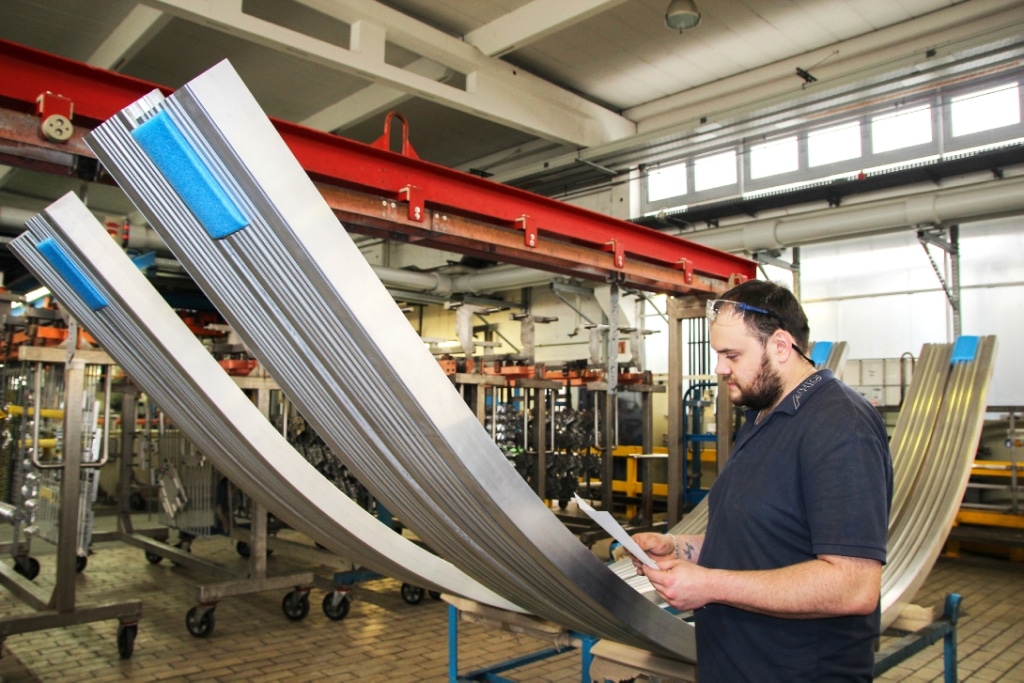used to increase the hardness and tensile strength
atmospheric hardening
what is hardening?
Hardening is a process for improving the strength, toughness, wear resistance, fatigue strength and hardness of metallic materials. The process involves heating and subsequent quenching or controlled cooling, which results in a significant increase in hardness. Either on the surface or over the entire cross-section of the component. In most cases, hardening takes place in conjunction with subsequent reheating, i.e. tempering.
the steel hardening process
The materials are hardened in a carbon-neutral inert gas atmosphere. The atmosphere is precisely matched to the carbon content of the respective material.
1. heating
At temperatures that are usually above 780°C, the initial microstructure of the component is first transformed into an austenitic microstructure. The workpiece is held at this temperature until the entire cross-section of the component has reached the austenitizing temperature and the microstructure has been homogenized.
2. quenching
The workpiece is then quenched so that a so-called hardening structure (martensite/bainite) is created. Quenching is a rapid cooling of the workpiece and takes place in oil, gas or other quenching media. Due to the changes that occur in the atomic lattice structures during heating and quenching, there are unavoidable changes in the shape and dimensions of the components.
3. tempering
The subsequent tempering sets the desired properties of the component, in particular the required hardness and toughness. Tempering is carried out at temperatures based on the required mechanical component properties. After protective gas hardening, an optional deep-freeze treatment can be carried out to transform the retained austenite. After a deep-freeze treatment, a further tempering process must always be carried out.
distinction between hardening and tempering
Hardening usually involves complete hardening across the entire cross-section of the component. Hardening and tempering therefore differ significantly from the process definitions of surface hardening or precipitation hardening.
All processes are carried out in highly developed, automated furnace systems that are specially designed to achieve the best possible results.
more details about metal hardening
atmospheric hardening
Atmospheric hardening is the hardening of components in an inert atmosphere. The surface of the component is protected from scaling and oxidation as well as from carburization and decarburization. Decarburization and carburization processes can be reversed by controlling the carbon potential in the inert gas atmosphere.
the theory of microstructural transformation
In its unhardened state, steel has a body-centered cubic lattice in which very little carbon can dissolve. After heating above approx. 720 °C, austenite is formed, which has a face-centered cubic (fcc) lattice and occupies a smaller volume. It can dissolve considerably more carbon, which takes place at hardening temperature. If the material is then cooled quickly enough, it transforms from a face-centered cubic lattice back into a body-centered cubic lattice. The presence of supersaturated carbon stretches the face-centered cubic lattice into a tetragonal lattice. This can also be referred to as transformation hardening. The martensite therefore has high residual stresses and a larger volume than unhardened steel at room temperature. The high residual stresses result in a high hardness of the material.
During subsequent tempering, a small amount of carbon diffuses out of the tetragonally distorted atomic lattice structure and forms carbides. This reduces residual stresses and volume changes, the hardness decreases and the toughness increases.
benefits of steel hardening
- Increased material strength: Hardening gives materials a robust structure and increases their resistance to external stresses.
- Increased service life: Hardening makes workpieces more resistant, which extends their service life and reduces the need for spare parts.
- Improved wear resistance: Hardened metal is less susceptible to wear, which improves the longevity of components and tools.
suitable metals for the hardening process
Virtually all technically interesting steel alloys, such as spring steels, cold forming steels, heat treatable steels, bearing steels, hot forming steels and tool steels as well as a large number of high-alloy stainless steels and casting alloys can be hardened.
The hardening of metals and steels in general is a very extensive subject. There are many different applications that can be used for different materials. If you are not sure which process is best suited to your purpose, we recommend that you speak to one of our experienced employees so that together we can select the best heat treatment for your application.
Choosing the right steel is crucial to achieving the desired properties.
application of steel hardening in various industries
The different hardening processes are not dependent on a specific industry, but on the material used and the mechanical properties to be achieved on the component.
benefits from our services, from the idea to series production
- Developing individual innovations
- Clarify detailed questions
- Support from the idea to series production
- First-class support
- Highest quality – whether small or large series
- Certified according to DIN EN ISO 9001:2015, VDA 6.1:2016
frequently asked questions about hardening
When hardening steel, the structure of the metal is transformed in such a way that the mechanical resistance of the metal is increased. The hardening process requires heat to be applied to the workpiece and then cooled quickly.
The temperature ranges for hardening depend on the respective steel composition. The temperatures that can be used can be found in standards, specifications and/or customer requirements.
Transformation hardening, precipitation hardening, solid solution strengthening.
The hardening temperature range for a particular material is standardized or defined in specifications. Basically, it can be said that the hardness to be achieved can be influenced by different hardening temperatures due to the different dissolution behavior of the carbon and the alloying elements. Higher temperature means higher hardness, lower temperature means lower hardness, but higher temperature also means a stronger dimensional change behavior of the components.
industries we serve
process locations
Any questions? Contact us directly or select a process location near you.

